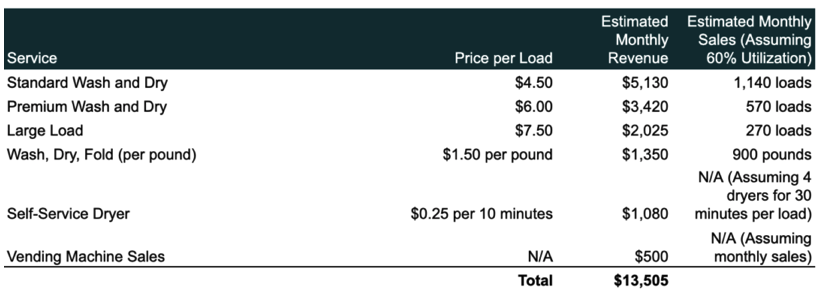
The laundromat industry in California has experienced changes in recent years. According to IBISWorld, the industry in California is expected to grow to $1.1 billion over the five years to 2023, with 2,094 establishments and 6,434 employees. Entrepreneurial endeavors, especially those in the service sector, find a welcoming environment in California’s varied and vibrant urban centers. In cities, where many people do not have access to a washing machine or dryer at home, the laundromat industry stands out as an essential service. Starting a laundromat in California is a complex process, but it offers the chance to be your own boss while also helping out your community, so it’s a good fit for many people.
Due to the ever-changing nature of the California market, environmental restrictions and resident lifestyle, opening a laundry in the Golden State is no ordinary undertaking. From researching the industry and the laws to finding the right spot and using technology to provide an exceptional experience for customers, this book will walk you through every aspect of opening a laundromat. This post is designed to provide readers, whether they are experienced company owners or just starting out, with the information they need to open and run a laundromat in the dynamic and varied state of California.
Importance of a Business Plan in Starting Your Own Laundromat in the USA
A comprehensive laundry business plan is the cornerstone of establishing a successful laundromat in the United States. Not only does it lay out the course of action for the entrepreneur’s journey, but it also helps in recruiting investors and obtaining funding. A well-written business plan helps a laundromat stand out in the crowded American service market and sets the stage for long-term success.
To begin, the goals and tactics of a company may be better articulated with the use of a well-thought-out business plan. This includes deciding in advance how the laundry will grow in terms of size, location, customer base and services provided. The process begins with extensive market research to learn about the demographics, tastes and habits of potential buyers. When choosing between a classic coin-operated model and a more contemporary card-operated facility with more facilities, this study is essential.
Also, you can’t do financial planning without a company strategy. It contains comprehensive predictions of initial investment, continuing operating expenditures and income. Consideration of costs including rent or ownership of a facility, washing machine acquisition, utilities and personnel is essential for laundromats. In addition to being essential in recruiting investors and obtaining loans, a well-prepared financial plan aids in the efficient management of these expenses. Before putting their money into a company, banks and investors want to know how profitable it may be.
The strategy goes on to detail the laundry’s marketing and operational initiatives. Included in this document should include the company’s pricing strategy, promotional activities and customer service procedures, all of which are meant to entice and keep consumers. The day-to-day running of the company, including personnel decisions, equipment upkeep and responding to consumer questions and concerns are all part of operational strategy.
Last but not least, a US laundry company plan has to think about the rules and regulations. This involves following all local health and safety laws, getting all required licenses and permissions and being environmentally conscious, especially with regard to water consumption and waste disposal.
Choosing the Right Location in California
The success or failure of your California laundromat company is heavily dependent on your choice of location. There are a lot of advantages and disadvantages for laundromats in this state due to its varied geography, which ranges from heavily inhabited cities to less populated suburbs. The success of the company depends on picking the correct location, which requires careful consideration of a number of important aspects.
- Demographic Analysis: It is very important to know who lives in the area. Laundromats tend to be in higher demand in neighborhoods that are home to many students, working-class families or renters. Locations that cater to apartment residents, such as San Francisco, Los Angeles and San Diego, might be excellent. To better address the requirements of the community, it is helpful to do research on the age, economic level and lifestyle of the population.
- Visibility and Accessibility: It is critical to choose a spot that is both prominent and conveniently accessible to those who could become clients. Locate your position as close to major thoroughfares as possible, such as supermarkets, retail malls and public transit stops. In places where public transit is scarce, having easy access and plenty of parking may be a huge selling point.
- Competition Analysis: It is essential to first evaluate the local competitors. Possibilities abound in areas where there are few or no other coin-operated washing machines. While there may be other laundromats in the area, you should think about ways to set yourself apart from the competition. Providing better equipment, more services (like dry cleaning) or a friendlier atmosphere are all examples of what may fall under this category.
- Real Estate Considerations: It is critical to locate in a reasonably priced area in California’s diverse real estate market. Real estate prices in California may range from very low to very high depending on where you are located. Make sure the site fits in with your budget and the estimates in your company strategy. One of the most important ways to control overhead is to negotiate the lease terms.
- Compliance with Regulations: Verify that the site meets all zoning, environmental and laundry-related restrictions set down by the state and municipality. It is not only the law but also the moral thing to do to follow California’s very strict rules on water use and garbage disposal.
Future Growth and Expansion: Consider the potential for future growth. A location that offers the possibility of expansion or is situated in a developing area can be advantageous as your business grows.
Profitability Analysis
Embarking on a laundromat venture in California requires a deep dive into the financial prospects and challenges of the business. A robust profitability analysis is indispensable, serving as a beacon for navigating the financial waters of this entrepreneurial journey. Here’s a structured approach to evaluate the financial potential of your laundromat business:
Initial Investment and Start-Up Costs Assessment
- Equipment and Setup: Calculate the investment for high-quality washing machines, dryers and other essential equipment. Don’t forget the fit-out costs for creating a welcoming and functional space.
- Regulatory Expenses: Include the fees for obtaining relevant licenses and permits, ensuring your business is compliant with California’s regulations.
- Consultancy and Legal Fees: Set aside a budget for legal advice, accounting services and consultations, which are critical in the initial stages.
- Insurance Considerations: Factor in the cost of comprehensive insurance policies to safeguard against potential risks and liabilities.
Ongoing Operational Cost Evaluation
- Utility Expenses: Given California’s utility rates, accurately forecast the costs for water and electricity, which form a significant chunk of recurring expenses.
- Maintenance and Upkeep: Allocate a budget for the regular maintenance of equipment and the facility, alongside a reserve for unforeseen repairs.
- Labor Costs: If employing staff, include their wages, training expenses and any benefits in your financial plan.
- Inventory and Supplies: Estimate the cost of consumables like laundry detergents and additional items for sale.
Revenue Projections and Pricing Strategy
- Service Pricing Analysis: Establish competitive pricing based on thorough market research. Consider diverse income streams, including laundry, dry cleaning and specialized services.
- Utilization Rates: Forecast machine utilization, factoring in peak hours and seasonal variations to predict revenue flow accurately.
- Additional Revenue Sources: If you plan on offering ancillary services, project these incomes separately for a clearer financial picture.
Break-Even Point Determination
Conduct a break-even analysis to pinpoint when your laundromat’s revenues will offset its operational costs, marking the onset of profitability.
ROI and Payback Period Calculation
- Return on Investment: Evaluate the profitability relative to your initial investment.
- Recovery Timeline: Ascertain the payback period to understand how long it will take for the business to recoup the initial investment costs.
Sensitivity Analysis for Financial Preparedness
Examine how variations in key financial elements like service rates or operational costs could impact your laundromat’s profitability, preparing you for market dynamics.
Industry Benchmarking
Compare your financial projections with industry standards and local competitors to gauge the competitiveness and viability of your business model.
Ultimately, a thorough profitability study goes beyond just predicting profits; it delves into comprehending the intricate financial aspects of operating a California laundromat as a whole. If you want to build your firm sustainably, attract investors and make smart judgments, you need this financial roadmap.

Strategic Marketing Solutions for Modern Businesses

How Traffic Management Businesses Are Improving Field Accountability

How to Plan a Last-Minute Holiday Trip with Instant Loan Support

How BRSR Reporting Software Is Transforming Corporate Sustainability Reporting In India

Discover Stylish Plastic Disposable Plates for Family Dining

Strategic Marketing Solutions for Modern Businesses

How Traffic Management Businesses Are Improving Field Accountability

How to Plan a Last-Minute Holiday Trip with Instant Loan Support









